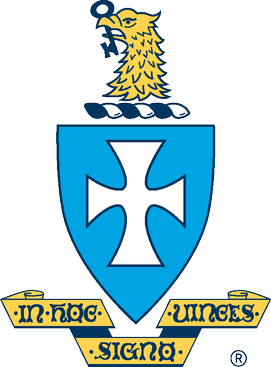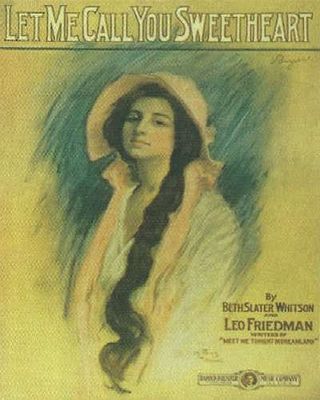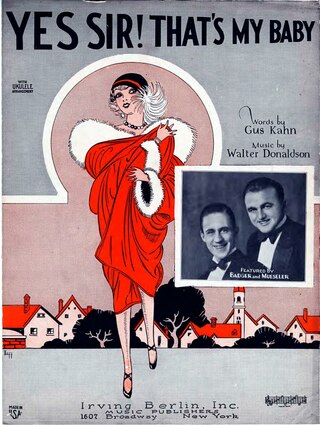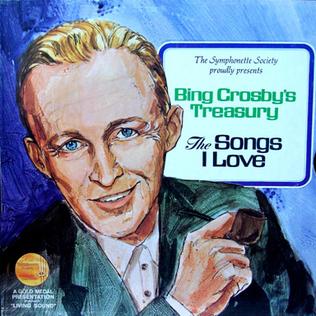
Albion College is a private liberal arts college in Albion, Michigan. The college was founded in 1835 and its undergraduate population was approximately 1,500 students as of Fall 2021.

Sigma Chi (ΣΧ) International Fraternity is one of the largest of North American social fraternities. The fraternity has 244 active undergraduate chapters and 152 alumni chapters across the United States and Canada and has initiated over 350,000 members. The fraternity was founded on June 28, 1855, at Miami University in Oxford, Ohio, by members who split from the Delta Kappa Epsilon fraternity.

"Moonlight Bay" is a popular song. It is commonly referred to as "On Moonlight Bay". The lyrics were written by Edward Madden, the music by Percy Wenrich, and was published in 1912. It is often sung in a barbershop quartet style. Early successful recordings in 1912 were by the American Quartet and by Dolly Connolly.
"Sometimes I'm Happy" is a popular song. The music was written by Vincent Youmans, the lyrics by Irving Caesar. The song was originally published in 1923 under the title "Come On And Pet Me," with lyrics by Oscar Hammerstein II and William Cary Duncan.

"Let Me Call You Sweetheart" is a popular song, with music by Leo Friedman and lyrics by Beth Slater Whitson. The song was published in 1910 and was a huge hit for the Peerless Quartet in 1911. A recording by Arthur Clough was very popular the same year too. A 1924 recording identifies a Spanish title, "Déjame llamarte mía".

"Nobody's Sweetheart", also known as "Nobody's Sweetheart Now" and "You're Nobody's Sweetheart Now", is a popular song, written in 1924, with music by Billy Meyers and Elmer Schoebel, and lyrics by Gus Kahn and Ernie Erdman. The song is a jazz and pop standard.

"Yes Sir, That's My Baby" is a popular U.S. song from 1925. The music was written by Walter Donaldson and the lyrics by Gus Kahn. It is now in the public domain.
"June in January" is a popular song with music by Ralph Rainger and lyrics by Leo Robin, published in 1934.

"Mississippi Mud" is a 1927 song written by Harry Barris, first sung by Bing Crosby as a member of Paul Whiteman's Rhythm Boys. Its musical composition entered the public domain on January 1, 2023.
"Five Minutes More" is a 1946 American pop song written by Sammy Cahn (lyrics) and Jule Styne (music). It is sometimes referred to as "Give Me Five Minutes More". It was featured in the movie Sweetheart of Sigma Chi, sung by Phil Brito, and was a number one hit record in 1946 for Frank Sinatra.

Theta Upsilon (ΘΥ) was a national women's fraternity operating in the United States from February 1921 until May 1962, when the group was absorbed by the Delta Zeta sorority.

"Goodnight, Sweetheart" is a British popular song written in 1931. It has been performed by Al Bowlly, Kate Smith, Connie Francis, Dick Haymes, Gordon MacRae, Sarah Vaughan and Dean Martin , among others, and was the theme song for the 1990s BBC time-travel sitcom Goodnight Sweetheart starring Nicholas Lyndhurst, which was named after it.
"Love Is the Sweetest Thing" is a popular song written in 1932 by British band leader and singer Ray Noble. Using guest vocalist Al Bowlly, Noble's recording was a big hit on both sides of the Atlantic, bringing Noble his first American success. It was published by Francis, Day & Hunter Ltd. Like most compositions published in the period, its main refrain is preceded with what were then called "sectional verses" or "introductory verses" which are usually omitted from early recordings and modern performances.
Auroratone films were produced by the Auroratone Foundation of America Inc. in Hollywood, Los Angeles, California. The films showed crystal-like abstract color patterns that changed and blended with each other. The patterns were produced by using crystallizing chemicals and polarized light, which were then synchronized to a variety of recorded musical tracks. The process was developed by English psychologist and scientist Cecil Stokes, who was the founder and technical director of the company. Stokes was issued patent 2292172 on August 4, 1942, for "Process and Apparatus for Producing Musical Rhythm in Color".

Favorite Hawaiian Songs, Volume Two is a compilation album of phonograph records by Bing Crosby released in 1946 featuring songs that were sung in a Hawaiian-type genre. This was the fifth Hawaiian-themed album release for Crosby.

Cowboy Songs is a compilation album of phonograph records by Bing Crosby released in 1939 featuring Western songs.
In North America, fraternities and sororities are social clubs at colleges and universities. They are sometimes collectively referred to as Greek life or Greek-letter organizations, as well as collegiate fraternities or collegiate sororities to differentiate them from traditional not (exclusively) university-based fraternal organizations and fraternal orders that have historically acted as friendly societies or benefit societies to certain groups unlike the ones mentioned in this article.

Bing Crosby's Treasury – The Songs I Love is an LP set recorded in 1965 and issued by a mail-order firm, The Longines Symphonette Society, an educational service of the Longines-Wittnauer Watch Company.

Bing Crosby's Treasury – The Songs I Love is an LP set by Bing Crosby, issued in both mono and stereo formats by a mail-order firm, The Longines Symphonette Society, which was an educational service from the Longines-Wittnauer Watch Company. A similar LP set had been issued in 1966, and this updated version had a total of 36 Crosby vocals.

"Never in a Million Years" is a song written by Mack Gordon and Harry Revel for the 1937 musical film Wake Up and Live when it was sung by Jack Haley. It had its biggest chart success by Bing Crosby featuring Jimmy Dorsey and His Orchestra. Crosby recorded it on February 28, 1937 and it reached #2 on the US pop chart the same year.















